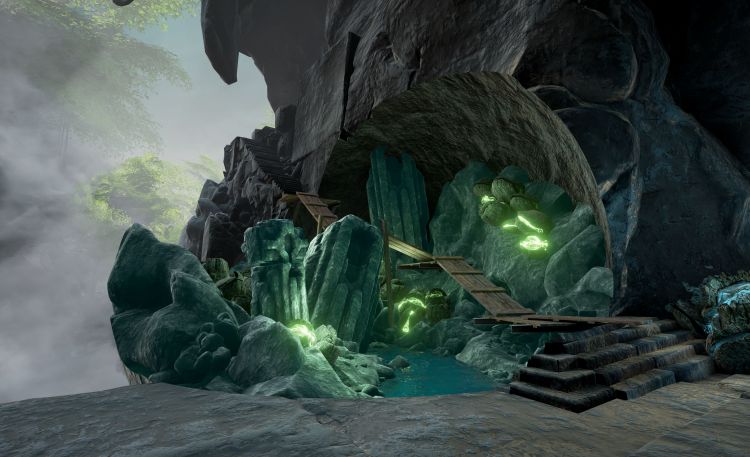“These early days are kind of like the Wild West,” Miller said.
Miller also added that the nodes were natural, given they cut their teeth on nodes in Myst, and they were always going to be part of Obduction.
There are some other problems I had with the VR versions as well, like having to physically turn all the way around to find a puzzle that was behind my character.
Getting lost
Of course, with the legacy of Myst such as it is, Obduction has to do something to appeal to fans of a popular and long-running franchise.
“Honestly, I think fans of our past stuff are going to feel a little deja vu,” Miller said. “Only because … and I think it’s because I like this feeling of being brought to a place I don’t know what went on. We could do that once in Myst.”
Miller explained that then, in the Myst sequels, players kind of knew what was going on. But in Obduction, which isn’t connected to Myst, it’s a whole new world to get lost in.
“This one’s fresh again,” Miller said. “It’s kind of nice having that clean sheet of paper.”
Just like the dock in Myst, players won’t know what’s going on.

Above: Something tells me getting this working won’t be as easy as hitting the “On” switch.
Miller also mentioned how much he enjoys Obduction’s opening area. Unlike Myst, where you can look all around from the beginning, Obduction’s initial area purposefully starts off in a dark, enclosed, small space that slowly opens up as you explore.
“I love reveals,” Miller said.
The Heartland
There’s one area of the game that Miller hasn’t talked about with anyone … until now. Miller didn’t want to give too many details, but there’s a “really magical place” in Obduction that the team hasn’t shown anybody yet called The Heart.
“Everybody at the office thinks it’s one of the coolest areas,” Miller said. “So, yeah, that’s one we haven’t really shared anything about.”
Old nightmares
In the glitz and glamour of E3, a quiet exploration-based game like Obduction can be a tough sell. It’s something more suited for long playtimes, not quick-and-dirty demos.
“The thing we have going for us now is, when we were demoing Myst back in the day, it was like nightmares,” Miller said.
People would play the game for a few minutes and not get it. They didn’t have a proper frame of reference for it. Now, people understand that games like Obduction open up questions and don’t give answers right away.
“But it’s still, yeah, it’s not the easiest to demo,” Miller said. “But you get the gist of it. It’s coming along nice.”
Little image of a big world
Obduction is a tricky one. I’ve never played Myst — but I’ve played games inspired by it — and after playing a bunch of good games at E3 this week, Obduction now struggles a bit to retain my attention.
Both demos also had a few glitches and bugs — I accidentally switched the game to free-walk mode and had to be reset to switch it back, and there were also problems with the loading speed of the game’s cursor — hopefully stuff that will all be fixed ahead of that game’s launch in July.
At the risk of repeating myself, it’s hard to judge a game like this with just a short demo, when it’s such a small slice of a large world. Obduction is interesting, I did enjoy my time with it, and I do it think will appeal to Myst and genre fans.
That being said, I’m not sure 100 percent sure it’s for me, or something I’ll make it back to. But I was intrigued and curious, and isn’t that really the point with a game like this?
VentureBeat's mission is to be a digital town square for technical decision-makers to gain knowledge about transformative enterprise technology and transact. Learn More





